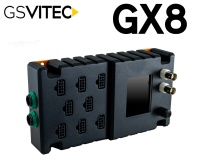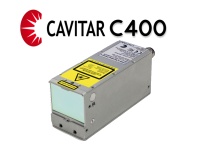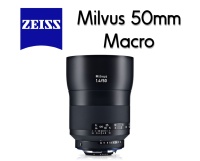- Description
- Specifications
- Videos
The Photron Crysta PI-1P polarization high speed camera is used to quantify and measure physical stress in transparent and semi-transparent fluids and solids. The Photron Crysta PI-1P polarization camera system can measure at 7,000 fps in full resolution operation or at 1.3 million fps when running at reduced resolution.
The Photron Crysta PI-1P high-speed polarization camera for the two-dimensional analysis of birefringence measurements, film thickness analysis, and surface roughness inspection, and is a powerful tool to understand phenomena such as birefringence, retardation, stress and impact fracture mechanisms of materials and fluids. This systems employ mechanical or electrical drives as polarization modulators, they require several photo-detection processes to measure polarization. In order to overcome this problem, The Photron Crysta PI-1P utilizes a high-speed 2D birefringence measurement system with a sampling rate of 1.3 MHz as the core device of the system with 16 parallel read out circuits in a matrix in the image sensor, which are connected to each pixel with individual A/D converters.
The image sensors design and fabrication incorporates a pixelated polarizer array which is made from photonic crystal bonded directly to the CMOS sensor, making the optical system in this sensor resistant to vibration. Each polarizer corresponds to each pixel of the image sensor with a one to one ratio. The size of each polarizer and pixel is 20 µm x 20 µm. In the polarizer array, groups of four neighboring polarizers (2 x 2) are set to have differing fast axis orientation at 0°, 45°, 90° and 135° in a clockwise arrangement. One polarization datum can be obtained by calculating detected light intensities from the four pixels of the image sensor. The parallel read-out circuit is arranged in a corresponding matrix.
The electric charges that represent the light intensities accumulated from each pixel are quantized by the multi-channel Analog/Digital converters and are stored in the memory of the camera. Once that is done. the software apply a phase shift analysis process to the stored data to obtain time-serial images of birefringent phase difference.
| 1024 x 1024 @ 7,000fps | |
|
Performance examples:
|
|
| 64GB | |
| 1,550,000 fps | |
| 369ns | |
| Gigabit Ethernet | |
| 12-bit | |
| Yes | |
| 2.98 sec at 1024 x 1000 @ 7500fps | |
| Global Electronic Shutter | |
| High-speed polarization image sensor | |
| 20 |
Related products
Photron high-speed cameras truly stand at the cutting edge of imaging technology, revealing motion details previously invisible to human perception. Throughout this exploration, we've seen how these remarkable systems capture fleeting moments at rates reaching 1,100,000 frames per second, essentially freezing time for scientific analysis.
The technical specifications demonstrate exceptional engineering achievement across multiple fronts. Frame rates stretching from 1,000fps to over 2 million fps allow researchers to observe phenomena occurring in microseconds, though resolution necessarily decreases at these extreme speeds. Resolution options from 1MP to 4MP provide flexibility for different applications, balancing detail capture against processing requirements.
Light sensitivity remains perhaps the most critical factor for successful high-speed imaging. Photron's adherence to ISO 12232 Ssat standards ensures reliable performance measurements, with monochrome sensors offering two to three times greater sensitivity than their color counterparts. This difference becomes crucial when capturing events requiring sub-microsecond exposures.
The practical aspects of Photron cameras deserve equal attention. Memory configurations reaching 128GB accommodate massive data generation, while global shutter technology eliminates distortion in rapidly moving subjects. Their compact, durable design withstands forces up to 160G, making these cameras suitable for the most demanding environments.
Applications across automotive testing, combustion research, and fluid dynamics showcase the versatility of these imaging systems. Scientists and engineers rely on their capabilities to solve complex problems invisible to conventional cameras.
Photron's extensive warranty and support network further strengthen their position as industry leaders. The combination of cutting-edge technology with comprehensive service ensures these cameras remain valuable tools for revealing the hidden world of high-speed motion. We now possess the ability to see beyond human visual limits, unlocking insights that continue driving scientific and engineering advancement across countless fields.
Frame Rate Capabilities in Photron High-Speed Cameras
Frame rate capabilities represent one of the most critical factors when selecting a Photron high speed camera. The number of frames per second determines how much detail you can capture in high-speed events, directly impacting your ability to analyze rapid phenomena effectively.
Frame Rate vs Resolution Trade-offs
One fundamental principle governs all Photron Fastcam systems: as frame rates increase, available resolution decreases. This trade-off occurs because higher frame rates require faster data processing and transfer rates. Consequently, the camera must process fewer pixels per frame to maintain these elevated speeds.
It's important to note that "the increased frame rate is never completely proportional to the reduction in resolution". Photron cameras have specific restrictions regarding which horizontal and vertical pixel combinations can be selected at different speeds. For instance, the Mini UX100 offers precise frame rate and resolution combinations as detailed in its specifications.
This relationship creates important considerations for users. If your application requires capturing fine details, you might need to sacrifice some temporal resolution. Conversely, if tracking extremely rapid events is paramount, you may need to accept reduced spatial resolution.
When selecting optimal settings, consider your specific needs carefully. For activities like automotive crash testing, fluid dynamics research, or combustion analysis, different combinations of resolution and frame rate might be appropriate. Additionally, memory capacity affects recording duration—higher frame rates fill memory buffers more quickly, potentially limiting total recording time.
The FASTCAM Mini R5-4K offers another excellent example of this relationship, providing 1,250fps at 4K resolution but increasing to 200,000fps at reduced resolution. Similarly, the Mini WX100 delivers 2048 × 2048 pixel resolution at 1,080fps or 1920 × 1080 pixel full HD resolution at 2,000fps.
For specialized applications, Photron cameras offer even more extreme capabilities. For instance, the E9 • 150S can achieve 2,720,000fps, albeit at just 640 × 32 pixels. Such extreme frame rates allow for the visualization of phenomena occurring at nanosecond timescales, such as shock waves, electrical discharges, or ballistic impacts.
Resolution and Image Clarity Considerations
Resolution quality sits at the heart of what makes Photron high speed cameras exceptional tools for scientific and industrial analysis. Unlike standard cameras where megapixels drive marketing, in high-speed imaging, the relationship between resolution, frame rate, and light sensitivity creates a complex balance that determines performance.
1MP to 4MP Sensor Options
Photron offers cameras with sensor resolutions typically ranging between 1-megapixel and 4-megapixel. This range provides flexibility for different applications and budgeting needs:
- The FASTCAM MINI NOVA S20 delivers 1-megapixel resolution (1024 × 1024 pixels) at frame rates up to 20,000fps in 10-bit or 16,500fps in 12-bit mode
- The Mini AX camera models provide 1-megapixel (1024 × 1024 pixels) image resolution with frame rates up to 2,000fps from the Mini AX50, 4,000fps from the Mini AX100, and 6,400fps in the AX200.
- The FASTCAM NOVA R5 offers 4-megapixel resolution (4096 × 2304 pixels) at 1,250fps
Indeed, higher-resolution sensors capture more detail, especially valuable when analyzing small objects or subtle movements.
Impact of Resolution on Field of View
Resolution directly influences what you can see and analyze in high-speed footage. Higher resolutions provide:
- More precise detection of small defects or subtle surface variations
- Better edge rendition for improved tracking in motion analysis applications
- Greater spatial detail across the entire field of view
According to imaging principles, the more pixels within a field of view, the better the resolution. However, this introduces a tradeoff - using a larger sensor to achieve more pixels means the imaging lens magnification and field of view will change.
In practical terms, when analyzing something like automotive crash testing or combustion processes, higher resolution allows observation of smaller components and subtle movements that might otherwise be missed.
Resolution vs Frame Rate Limitations
Perhaps the most crucial consideration is that resolution and frame rate exist in an inverse relationship. As resolution increases, maximum achievable frame rate decreases. This fundamental limitation exists because:
- With a 4-megapixel camera, you're processing four times more pixels than with a 1-megapixel camera
- Higher pixel counts require more data bandwidth and processing power
- Memory fills faster with larger frame sizes
This relationship creates specific performance profiles. For example, the FASTCAM NOVA R5 offers:
- 4096 x 2304 pixles at 1,250fps
- 2048 × 2048 pixels (full 4MP) at 2,880fps
- 1920 × 1080 pixels at 5,280fps
- 1280 × 720 pixels at 8,000fps
- 2048 × 8 pixels at 100,000fps
Despite this limitation, Photron cameras offer innovative solutions. Many newer models feature binning technology, where adjacent pixels can be combined to increase sensitivity and frame rate at reduced resolution.
Considering the application's specific needs remains paramount when selecting a photron camera. For microscopy, detonics, and combustion imaging, a 1:1 sensor format (square) often provides greater flexibility than 'letterbox' formats. Fortunately, most photron cameras offer Region of Interest (ROI) capabilities, allowing users to select specific portions of the sensor to achieve higher frame rates when full resolution isn't necessary.
Light Sensitivity and ISO Performance
Light sensitivity remains the cornerstone of effective high-speed imaging, often determining the success or failure of capturing rapid phenomena. In many applications, it becomes "the single most critical consideration when it comes to purchasing a high-speed camera" since it affects everything from exposure time to image quality and focus capabilities.
High ISO Ratings in Low-Light Conditions
Photron cameras offer impressive sensitivity ratings suited for challenging lighting environments. The FASTCAM Mini UX100 achieves "ISO 10,000 monochrome, ISO 5,000 color" under the stringent Ssat standard. For even more demanding applications, the FASTCAM NOVA delivers extraordinary sensitivity rated at "ISO 40,000 monochrome, ISO 16,000 color".
These high ISO capabilities prove crucial because:
- They enable shorter exposure times to eliminate motion blur
- They improve image quality in low-light conditions
- They enhance focusing ability, particularly with microscope or telescope lenses
For specialized applications requiring maximum sensitivity, many Photron cameras extend beyond visible light. The monochrome sensors in the FASTCAM Mini UX are "supplied without an IR absorbing filter, extending the camera spectral response beyond 900nm". This extended spectrum response further increases effective sensitivity—when measured including near IR response, the Mini UX reaches "an equivalent value of ISO 25,000" and the NOVA achieves "an equivalent value of ISO 100,000".
Naturally, higher ISO settings come with trade-offs. As ISO increases, so does the potential for noise or grain in the image. Modern digital sensors mitigate this issue substantially, yet the principle remains that "high ISO settings can lead to brighter images but may introduce noise or grain, affecting the overall quality".
Monochrome vs Color Sensor Sensitivity
Perhaps the most significant decision affecting light sensitivity is choosing between monochrome and color sensors. Technical documentation clearly states that "a monochrome camera will be two to three times more sensitive than the equivalent color camera". This substantial difference exists because "monochrome sensors collect more light per pixel because they aren't filtered for color".
This sensitivity advantage occurs because color sensors require Bayer filters that block approximately two-thirds of incoming light to separate colors, while monochrome sensors capture all available light. Additionally, monochrome imaging "provides higher contrast levels, enhancing defect detection" and eliminates the need for Bayer interpolation, which can reduce sharpness.
Marketing departments typically prefer color footage since "people see in color, so they prefer to watch color videos rather than monochrome videos". Yet for scientific and technical applications where maximum light sensitivity is paramount, monochrome sensors typically yield superior results unless color information is essential to the analysis.
Minimum Exposure Time and Motion Blur Elimination
Capturing crystal-clear images of ultra-fast phenomena demands extraordinarily brief exposure times. Photron cameras excel in this area, offering exposure durations measured in microseconds and even nanoseconds to completely eliminate motion blur that would otherwise render high-speed events indecipherable.
Sub-Microsecond Exposure in Fastcam Series
Photron's engineering prowess shines through their remarkably short exposure capabilities. The Mini AX models deliver a standard minimum exposure duration of 1μs (one microsecond), with sub-microsecond options available on the MINI AX200 model, although these may be subject to export approval.
Even more impressive, the NOVA S20 supports an extremely brief 0.2μs minimum exposure while still capable of recording at speeds up to 1,100,000fps at reduced image resolutions. This sub-microsecond capability proves vital because many high-speed events require extraordinarily short exposures—sometimes less than a single microsecond—to completely freeze motion.
For applications demanding the absolute pinnacle of exposure performance, Pharsighted specialized models deliver truly astonishing specifications:
- The E9•150S achieves a minimum exposure time of just 34ns (nanoseconds)
- The E9•100S offers 59ns minimum exposure
- The E9•80S and E9•50S models provide 98ns minimum exposure
These incredibly brief exposure times—measured in billionths of a second—enable researchers to capture phenomena invisible not just to human vision but to most imaging systems. For comparison, the E9•150S exposure of 34ns is approximately 29,000 times shorter than the blink of an eye.
Achieving such short exposures requires both technological excellence and practical considerations. First, "the camera's sensor must be capable of performing such a short exposure". Second, adequate light sensitivity becomes absolutely crucial since "when it does use a sub-microsecond exposure it can capture enough photons of light to generate video that is of sufficient quality for analysis".
Global Shutter for Blur-Free Imaging
Beyond exposure duration alone, Photron cameras implement global shutter technology—a critical feature for high-quality high-speed imaging. Unlike rolling shutters that expose rows of pixels sequentially, "global shutter sensors capture an entire frame in a single exposure, eliminating motion artifacts and distortion".
This synchronized exposure timing proves essential because "global shutter technology ensures every pixel starts and stops exposure at the same time". The practical benefit is straightforward: blur-free images even of extremely fast-moving subjects.
Global shutter functionality particularly matters in applications involving:
- Industrial inspection where products move rapidly on conveyor belts
- Automotive testing with vehicles and components in high-speed motion
- Scientific research examining phenomena like combustion or fluid dynamics
- Robotics where precise visual tracking enables faster operations by up to 50%
The alternative—rolling shutter technology—introduces significant distortion issues because it "exposes and reads each row of the image sequentially from top to bottom" resulting in "time lags between rows that distort fast-moving scenes". For photron camera users, this would be unacceptable.
In fact, the synchronized exposure across all pixels delivers an additional critical benefit for scientific and technical applications: "temporal alignment" where "each pixel in the image corresponds to the same point in time". This exact temporal correspondence makes measurements of distances, speeds, and trajectories substantially more accurate.
Together, sub-microsecond exposures and global shutter technology enable photron cameras to produce the extraordinarily crisp, blur-free images essential for detailed analysis of high-speed phenomena across countless scientific and industrial applications.
Internal Memory and Data Handling in Photron High Speed Cameras
The data handling capabilities of Photron high speed cameras play a vital role in their performance for high-speed imaging. Given that these systems generate enormous volumes of information in fractions of a second, robust memory and efficient data transfer methods become essential considerations for professionals seeking optimal performance.
Up to 128GB Internal Memory in Fastcam Models
Memory capacity directly impacts recording duration at high frame rates, with Photron offering multiple configuration options across their camera lineup. The FASTCAM NOVA high speed camera models features impressive memory options ranging from 8GB to 128GB, enabling researchers to capture longer sequences without sacrificing resolution or speed. Likewise, the FASTCAM Mini series provides 8GB, 16GB, or 32GB variants, balancing cost with performance requirements.
For specialized applications requiring extended recording capabilities, the MH6 LT delivers 60GB of memory divided between connected camera heads, coupled with a 1TB SSD for immediate backup. Other premium models feature even more substantial capacities, as seen in certain configurations offering up to 128GB internal memory with optional removable solid state drives up to 4TB.
Memory partitioning represents an additional advantage in several Photron models. The FASTCAM NOVA series allows users to divide recording memory into multiple active sections, enabling simultaneous recording of an ongoing event in one partition while downloading previous footage from another. This sophisticated feature substantially improves workflow efficiency during time-sensitive research.
Memory Calculation Based on Bit Depth and Duration
Determining required memory capacity involves understanding the relationship between resolution, frame rate, recording duration, and bit depth. Generally, higher values in any of these parameters increase memory demands exponentially.
To calculate memory requirements, Photron provides these formulas:
- For 12-bit sensors: (H resolution × V resolution × frame rate × seconds × 1.5) = memory in bytes
- For 10-bit sensors: (H resolution × V resolution × frame rate × seconds × 1.25) = memory in bytes
- For 8-bit sensors: (H resolution × V resolution × frame rate × seconds × 1.0) = memory in bytes
Practically speaking, a high-end Photron camera recording at 20,000fps with 1-megapixel resolution can generate approximately 62.91 gigabytes of 12-bit image data in just 2 seconds. Initially, this might seem excessive, yet many scientific and industrial applications demand precisely this level of detail and duration.
Data Offload via Gigabit Ethernet and SSD
Once footage is captured, transferring it from internal memory becomes the next challenge. Photron implements several solutions to address this bottleneck. Most models feature Gigabit Ethernet interfaces, while advanced cameras offer dual Gigabit Ethernet connections to double transfer speeds.
Beyond standard networking, many Photron cameras incorporate faster options:
- 10 Gigabit Ethernet connections enabling transfer speeds up to five times faster than using internal CFast cards
- The FASTDrive system allowing transfer of 64GB camera memory to removable SSD media in approximately one minute
Network protocol selection fundamentally affects transfer efficiency. Photron's implementation of UDP protocol instead of TCP/IP significantly reduces overhead, resulting in transfer speeds up to 5GB per minute. This optimization becomes particularly valuable when working with large datasets generated during high-speed recording sessions.
Most photographers and videographers frequently confuse megabits (Mbps) with megabytes (MB/s). For reference, 100Mbps equals 12.5MB/s because eight bits equal one byte. Understanding this distinction helps properly evaluate data transfer capabilities across different photron camera interfaces.
Camera Size, Durability, and Tethered Head Design
Physical design considerations often determine whether a photron camera can be practically deployed in challenging environments. The engineering behind these high-speed imaging systems reflects careful attention to size, durability, and operational flexibility—essential qualities for capturing footage in extreme conditions.
Tethered Design for Safety and Flexibility
The tethered design philosophy separates camera heads from processing units, providing unique advantages in hazardous testing environments. In addition to size benefits, this architecture ensures that image data remains secure even if a camera head is damaged or destroyed during explosive events.
For applications requiring multiple viewing angles, the MH6 system allows connection of up to six miniature camera heads to a single processor. This configuration proves particularly valuable for on-board crash testing where space and weight constraints severely limit camera placement options.
Ultimately, the combination of compact size, exceptional durability, and tethered architecture enables Photron cameras to capture crucial high-speed footage in environments that would destroy conventional imaging systems. These design considerations transform theoretical capabilities into practical tools for automotive safety testing, explosives research, and other demanding applications.
Support, Warranty, and Vendor Reliability
Behind every exceptional Photron camera stands a robust support infrastructure that ensures optimal return on investment. When selecting high-speed imaging equipment, buyers must consider not just technical specifications but equally important after-purchase support services.
2-Year Standard Warranty
Photron offers an industry-leading 2-year standard warranty on all newly purchased high-speed camera products at no additional charge. This comprehensive coverage includes all parts and labor—a guarantee unprecedented in the high-speed imaging market.
The warranty period begins from the shipment date received to your facility. Should a system malfunction due to manufacturing defects within this period, it will be repaired without charge. Nonetheless, certain exemptions apply, namely damage from fire, earthquake, water, natural disasters, and abnormal voltage.
On-Site Demonstrations and Training
Tech Imaging Services provides complete on-site demonstrations and training with turnkey solutions to ensure customer success. Secondly, hands-on seminars bring cutting-edge imaging solutions directly to customers' facilities, delivering real-world demonstrations and expert insights tailored to specific industries.
Export Disclaimer: Some goods on this site may be subject to US Export Regulations. Buyer agrees as one of the terms of purchase not to export such goods without having obtained and executed proper export licenses from the United States Government. Learn more.





